Garden at the Top of the World
Copyright © 2003 by Richard S. Platz
All Rights Reserved

Little Duck and Eaton Lakes Backpack
Russian Wilderness
June 28, 2003, to July 3, 2003
Big ants, small ants forage
In the garden of the Buddhas
Puzzling over maps and hiking books, telephoning ranger stations,
and consulting computerized topo maps, I worried over our next
destination as if it were key to solving the Grand Unification
Theory. In the last week of June Barbara cut to the heart of the
matter by scrawling "Duck Lake?" on a small,
square, yellow Post-It label and sticking it on my place mat at
the dinner table.
Amidst a heat wave, with temperatures in Blue Lake in the high
90's, we prepared for backpacking to Duck and Eaton Lakes. Mid-day
on Saturday we left in our newly reconditioned (and air-conditioned)
van, had lunch at Cinnabar Sam's in Willow Creek, and refueled
in Weaverville. On a hairy curve on Highway 3 going up Scott Mountain
we pulled over to help a fellow motorist. With two blown tires
his car straddled the rocky shoulder, half on and half off the
road. Had we not ourselves recently received similar aid, we would
no doubt have passed by this pudgy fellow in his effeminate black
silk shirt. Even so, Barbara hung back, smelling an incipient
ambush. Unsurprisingly, there was no cell phone service. The man
eschewed my offer for a ride, preferring to stay with his worldly
possessions, all of which seemed to bristle from his disabled
vehicle. So we offered instead to phone the Highway Patrol for
him from Callahan.
Into the twilight of Callahan's only bar we stepped like pilgrims
into a den of brooding outlaws. The patrons eyed us warily as
we explained our need to borrow a phone to call the CHP, then
immediately fell to debating the merits of our proposal. "It'll
take'em three hours jus' t'git there," one argued loudly,
to which others assented or disagreed in accordance with their
current mood. Everyone had an opinion, but no one lifted a hand
to do anything other than order another round. The consensus was
to send "Dick" out to help the stranded motorist, but
no one appeared willing to actually pick up the telephone and
call this Dick, or even disclose to us his whereabouts.
So we withdrew, headed up the road to Etna, and dialed 911 from
a pay phone outside Bob's Ranchhouse. Crossing Scott Mountain
Summit had apparently thrown us into a discordant Highway Patrol
dimension. Solving problems from another district was not in this
dispatcher's job description, so it took some cajoling to get
her to check with the Susanville district. Someone, it turned
out, had already called. An officer was on the way.
Our civic duty discharged, we ate dinner at Bob's, one of Barbara's
favorite eateries. After dinner, we headed back south toward Callahan,
then turned off and followed French Creek Road southwest as it
climbed towards the Russian Wilderness. The trailhead eluded us
at first. Someone had removed signs at a few of the critical crossroads,
perhaps for souvenirs, or to keep the trailhead a secret, or simply
out of pure vandalism. I pulled out the eTrex G.P.S. receiver,
into which I had entered the coordinates of the parking area,
and we reversed our direction and homed in on the trailhead. Soon
we pulled into a large, flat, graveled area with the trailhead
sign at the far end and two vehicles crowded nearby, a full-sized
pickup and a small wagon.
The G.P.S. reported the trailhead to be at an altitude of 4470
feet. The federal government, we knew, intentionally introduced
fuzziness into the altitude coordinate to throw terrorists off.
Art Bernstein reported the trailhead to be 4800. In either case,
Little Duck and Eaton Lakes lay roughly 2000 feet above us. We
would spend the night in the van and backpack in the next morning.
As we were moving things off the bed in the van, a young woman
in her twenties hiked in from the trail, heaved off her backpack,
and dumped it into the back of the pickup. In response to our
inquiries, she told us that she and her friends had been at Big
Duck Lake, and the only others there were her parents, who planned
to hike out tomorrow. I asked if she knew whether anyone was camped
at Little Duck Lake, and she responded, "My father hiked
over there and said it was full."
Her cryptic response seemed odd, since the only two cars at the
trailhead belonged to her and her parents. Whence came all the
other campers? Could they be horse-packers from Paynes or Horse
Range Lakes?
Before we could puzzle it out, a second young woman labored in.
"Thank fuckin' God!" she snorted and dropped
her pack in the dirt beside the truck.
A moment later she was followed by a young man, his unstuffed
sleeping bag draped like a halter over his pack. "That,"
he proclaimed, arms dangling at his sides, apparently too tired
to remove his backpack, "is a hard hike!"
They quickly wrestled their backpacks into the bed of the pickup
truck, then climbed into the station wagon and drove off. I walked
over and examined their equipment strewn about the truck bed,
open to the whole world, vulnerable to thieves and pirates. Ahrrr,
trusting souls they be. The gear was low-tech and heavy, as
if picked up hastily at K Mart or a garage sale. The sleeping
bags lay draped unstuffed over the packs.
We stretched our legs by walking up the road until we could view
Mount Shasta. We saw a tanager. Planning an early start for cool
morning hiking, we packed our backpacks as much as we could before
bedtime.
Sunday morning we awoke at 5:30, ate a quick bowl of oatmeal,
and were on the trail by 7:15. From the beginning the hike was
very steep going, but at least the tall forest provided shade.
The trail started up the rocky tread of an abandoned logging road,
then switched-back up a granitic moraine, crossing, but not following,
several logging roads of more moderate grade that once provided
access to two higher trailheads, now permanently closed. At one
road crossing we encountered the wilderness boundary sign planted
like a grave marker in the yellow dirt. At the third or fourth
crossroad, the trail hair-pinned left and followed its more level
grade south, winding into an ever deepening woods. Here we could
walk side-by-side, occasionally skirting a water bar or washout
that rendered the route impassable to motor vehicles, and breathe
in the ambience of the forest.
Our first rest stop was the Eaton Lakes trail junction at 5655
feet, which a few years ago had been the highest parking area
for both the Eaton and Duck Lakes trailheads. Having already climbed
a thousand feet, we happily set down our packs and stretched.
Across gurgling Duck Lake Creek we saw the trail which would contour
a half mile around the mountain, then shoot straight up an impossible
staircase of loose granite scree to Eaton Lakes. A hundred feet
further up the road was the turnoff to the Duck Lakes. The road
itself continued on to Horseshoe Lake, which we remembered to
be a hot, daunting, and marginally rewarding trek. As we pondered
between Eaton and Duck Lakes, a father and small son passed us,
heading up to Duck Lake for the day to fish.
Then the parents of the girl we had debriefed at the parking
lot stopped to chat on their hike out. We again asked about Little
Duck Lake, and the father said no one was there. That's not what
his daughter had told us. On further questioning, he explained
that his statement to his daughter meant the lake was full
of water, not that the campsites were full of people. We
had a good laugh at the misunderstanding. We mentioned the gear
laying unattended in the back of his pickup, and he said he never
had a problem. People didn't steal things around there.
 We
had been unsure which lake to visit first, but now decided definitively
on Little Duck. The trail climbed steeply through the thick forest
along the west slope of the drainage. Almost immediately we encountered
huge trees, blown down by the wind, blocking the trail. Each one
required an off-trail scramble up and around on the slippery duff
and vegetation of the steep bank, a task made more precarious
by the high balance of our backpacks. The trail soon eased a bit
as we entered the cathedral of Duck Creek's upper valley. A forest
of red fir, western white pine, mountain hemlock, and an occasional
Brewer spruce supported a high vaulted ceiling above the U-shape
valley into which little sunlight penetrated. Through a valley
floor strewn with boulders and logs left by the high water and
snow of innumerable Springs, the trail wound up the moraine on
the west side of the creek. At least thirteen other conifer species
are also reputed to be found in Duck Creek's Special Interest/Botanical
Area. We were too tired to care. Sweating and puffing, we wondering
why this leg always seemed so much longer than the map allowed. We
had been unsure which lake to visit first, but now decided definitively
on Little Duck. The trail climbed steeply through the thick forest
along the west slope of the drainage. Almost immediately we encountered
huge trees, blown down by the wind, blocking the trail. Each one
required an off-trail scramble up and around on the slippery duff
and vegetation of the steep bank, a task made more precarious
by the high balance of our backpacks. The trail soon eased a bit
as we entered the cathedral of Duck Creek's upper valley. A forest
of red fir, western white pine, mountain hemlock, and an occasional
Brewer spruce supported a high vaulted ceiling above the U-shape
valley into which little sunlight penetrated. Through a valley
floor strewn with boulders and logs left by the high water and
snow of innumerable Springs, the trail wound up the moraine on
the west side of the creek. At least thirteen other conifer species
are also reputed to be found in Duck Creek's Special Interest/Botanical
Area. We were too tired to care. Sweating and puffing, we wondering
why this leg always seemed so much longer than the map allowed.
It was late morning before the trail crossed over to the creek
and we came at last to the junction to Big Duck Lake. Signs nailed
to a tree pointed to Big Duck, across the creek, and Little Duck
on up the Valley. We stopped for a break. My lateral malleolus
was bothering me. Mosquitoes quickly sniffed us out, and we had
to slap on bug juice. The easy trail to Big Duck, rising out of
the forest into blindingly white granite boulders, was tempting.
Big Duck's waters lay only a half mile away and less than two
hundred feet up. Little Duck was still at least a mile away and
a five hundred foot climb.
But we had already camped once at Big Duck, and we both remembered
Little Duck to be the more attractive lake. Besides, fewer people
were likely to camp at Little Duck. So after a breather, we pressed
inexorably on. The trail soon rose out of the forest, became difficult
to follow as it wound across a high divide of bright granite bedrock,
then dropped back into the forest of the shallower upper valley
just below Little Duck Lake.
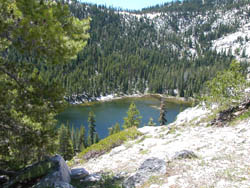 We
arrived for lunch after climbing somewhere between 1900 and 2300
feet (depending on the dubious altitude of the trailhead). Little
Duck Lake sits in a forested steep granite cirque at 6700 feet
just beneath the spine of the Russian Peak Pluton dividing the
Scott Valley from the Russian Creek drainage to the southwest.
Snow crowned the north face of the ragged ridge just south of
the lake and reached all the way down to water's edge, with impressive
waterfalls high on the granite cliffs. We
arrived for lunch after climbing somewhere between 1900 and 2300
feet (depending on the dubious altitude of the trailhead). Little
Duck Lake sits in a forested steep granite cirque at 6700 feet
just beneath the spine of the Russian Peak Pluton dividing the
Scott Valley from the Russian Creek drainage to the southwest.
Snow crowned the north face of the ragged ridge just south of
the lake and reached all the way down to water's edge, with impressive
waterfalls high on the granite cliffs.
The weather was warm, but windy. We chose a campsite in the wildly
mixed conifer forest beside an outcropping of glacier-polished
granite that formed the northeast shore of the lake. We identified
western white or white bark pine, Ponderosa pine, sugar pine,
lodgepole pine, mountain hemlock, Brewer spruce, and red fir.
Phlox, shooting stars, and snow plant added a touch of color to
the patchy ground cover.
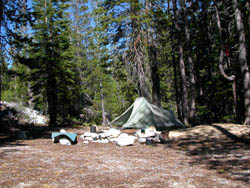 I
dove in for a swim while Barbara waded in the shallow beach of
granite sand. The water was cold, but not unbearable. Doggedly
we set up camp, built our fire, ate a freeze-dried dinner, and
washed up. An osprey fished while a tanager flitted through the
branches and juncos foraged. From our hammocks we heard mountain
chickadees, a nuthatch, a Steller's jay, and, further away, an
owl and a woodpecker. Later we sat by the water until the bats
came out. Oddly, we saw no deer or rodents, although we did hear
something small steal away with a food bar wrapper. We turned
in early. I
dove in for a swim while Barbara waded in the shallow beach of
granite sand. The water was cold, but not unbearable. Doggedly
we set up camp, built our fire, ate a freeze-dried dinner, and
washed up. An osprey fished while a tanager flitted through the
branches and juncos foraged. From our hammocks we heard mountain
chickadees, a nuthatch, a Steller's jay, and, further away, an
owl and a woodpecker. Later we sat by the water until the bats
came out. Oddly, we saw no deer or rodents, although we did hear
something small steal away with a food bar wrapper. We turned
in early.
Monday morning we awoke to beautiful weather, not too hot, and
just windy enough to keep the bugs away. We boiled water, prepared
our morning cups, then sat on the smooth granite slab at water's
edge.
I sipped my mocha coffee and watched a black ant crawl up a dead
pine snag, trying one branch stub, turning back at its dead end,
climbing, trying another, foraging fruitlessly. No blame. If souls
transmigrate, why would they not do so outside the illusion of
time? Why must one be reborn later in time? Why not earlier?
Or at the same time as one's other incarnations. Perhaps
for all incarnations, there is but one soul. Parallel
reincarnation. Is this what is meant by the oneness of the Buddha?
Perhaps this is the root of all compassion: we are in fact
all one. Hurting or killing a sentient being is hurting or killing
oneself. I am the ant foraging up the dead pine snag.
Slapping a mosquito, I was expelled rudely from Buddhism back
into the Judeo- Christian world of Good and Evil. Evil may be
destroyed. Must be destroyed. Our elected leaders, those
darlings of the Christian right wing, declare what is Good and
what is Evil with the conviction of divine revelation. Our military
might is unleashed to overthrow Evil. Root it out. Crush it. Collateral
damage is unavoidable in the crusade for Good.
 Westerners
criticize Buddhism as a "do nothing" world view, which
allows Evil to flourish. What they do not see is that Good and
Evil are in the eye of the beholder. The Evil they rage against
and the Good they embrace both arise, figuratively and literally,
from a vision already distorted by that biblical dichotomy. But
to an undistorted eye, to a compassionate eye, are not Good and
Evil just two different views of the same thing? Westerners
criticize Buddhism as a "do nothing" world view, which
allows Evil to flourish. What they do not see is that Good and
Evil are in the eye of the beholder. The Evil they rage against
and the Good they embrace both arise, figuratively and literally,
from a vision already distorted by that biblical dichotomy. But
to an undistorted eye, to a compassionate eye, are not Good and
Evil just two different views of the same thing?
Motionless on a stone seat nearer the water, Barbara, by contrast,
became the Buddha. Unaware of my internal babble, she drank
her green tea quietly. Her discursive mind quieted. At one with
nature, she beheld the reality-unreality of being there
completely at the water's edge. Beyond words.
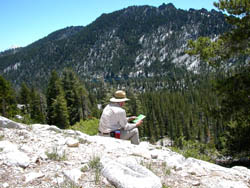 Late
that morning we hiked sluggishly up the slope above our campsite
as far as the steepening valley wall safely allowed. From the
sparsely forested granite mountainside we could look out over
both Big Duck and Little Duck Lakes and beyond our cirque to Mt.
Shasta's snowy summit in the distance. The Duck Creek valley curved
down and away to the northeast to join French Creek. Beyond the
forested slope above Big Duck Lake rose the spires of Eaton Peak,
and we looked for a shortcut up to Eaton Lakes, which would save
us a thousand-foot descent to the Eaton Lakes trailhead and a
thousand-foot climb back up to the lakes. But from our vantage,
no easy route was obvious across the rough terrain of steep granite
slopes. Late
that morning we hiked sluggishly up the slope above our campsite
as far as the steepening valley wall safely allowed. From the
sparsely forested granite mountainside we could look out over
both Big Duck and Little Duck Lakes and beyond our cirque to Mt.
Shasta's snowy summit in the distance. The Duck Creek valley curved
down and away to the northeast to join French Creek. Beyond the
forested slope above Big Duck Lake rose the spires of Eaton Peak,
and we looked for a shortcut up to Eaton Lakes, which would save
us a thousand-foot descent to the Eaton Lakes trailhead and a
thousand-foot climb back up to the lakes. But from our vantage,
no easy route was obvious across the rough terrain of steep granite
slopes.
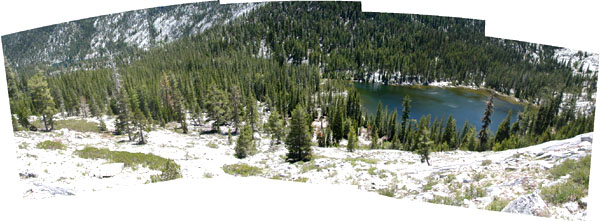
After lunch we hiked leisurely around Little Duck Lake and found
good campsites on the north side and at the inlet. On the south
side of the lake we crossed on boulders high up the slope to avoid
the snow. When we got back to camp, we jumped in for a short,
invigorating swim. Later we hiked down the trail, but not far
because the mosquitos came out as the day cooled and the wind
died down. The entire stay at Little Duck Lake we saw and heard
no one else.
On Tuesday we arose fairly early to sit, eat breakfast, and break
camp. On the trail by 9 AM, we hiked down and down through Duck
Creek's tall forested valley, failing utterly to notice the junction
with Big Duck. Inattention thus saved us from attempting a cross-country
maneuver from Big Duck to Eaton. Again we skirted the blown-down
trees and dropped to the logging road at the old trailhead.
We stopped briefly at the Eaton Lakes trail junction, then boulder-hopped
across the stream to begin our climb to Eaton Lakes. At first
the route was wet and muddy, then hard to follow through a maze
of small blowdowns until it rose out of the swamp to cross exposed
bedrock. This segment was lovely as it contoured through the open
forest. Before long the trail took a sharp right turn and climbed
a series of steep logging roads gouged into the glacial till,
then straight south up the spine of a long, exposed moraine. We
could not find the "trail" sign we had missed the last
time we hiked down from Eaton Lakes and could not agree where
we had taken our wrong turn. As the moraine finally joined the
main bulk of the mountain, the trail began to switchback up the
impossibly steep mountainside through a dense forest of predominantly
red fir. Soon we began to encounter blown down trees blocking
the trail. One after another we clambered over, under, or cross-country
around a dozen downed or deeply nodding trees, many rare Brewer's
spruce. Off-trail, the slope was steep and dangerous. Progress
became laborious, and our pace slowed. Our backpacks grew heavy.
We were soaked with sweat. Stopping at last for a breather on
an open slash of granite talus, we heard gurgling beneath the
sharp white rocks the beginning of French Creek as it flowed down
from lower Eaton Lake.
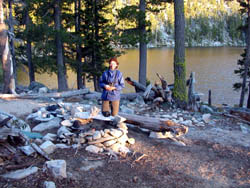 As
we finally approached the crest, the trail splintered and grew
vague. Apparently all routes led to the lake. Barbara followed
the most prominent track and at long last the waters of the larger
Eaton Lake glistened in the sunlight. We followed the main path
past several small campsites to the largest campsite near the
water's edge. Exhausted, we decided a swim would help revive us.
From a sloping slab of granite we plunged into the shallow waters
of a cove near the outlet. The water was warmer than at Little
Duck, probably because snow did not reach down to lake level here. As
we finally approached the crest, the trail splintered and grew
vague. Apparently all routes led to the lake. Barbara followed
the most prominent track and at long last the waters of the larger
Eaton Lake glistened in the sunlight. We followed the main path
past several small campsites to the largest campsite near the
water's edge. Exhausted, we decided a swim would help revive us.
From a sloping slab of granite we plunged into the shallow waters
of a cove near the outlet. The water was warmer than at Little
Duck, probably because snow did not reach down to lake level here.
The campsite we chose was a fine one, with a level
tent site, a nice fire ring capped with a broad flat rock, and
hammock trees at the water's edge. Along the bank grew wild roses,
miniature azaleas, and patches of shrubby alder. Between our tent
and the water, silver-gray logs fallen in seasons past lay crisscrossed
like pick-up sticks. At Little Duck Lake the high ridge had blocked
the sun by seven in the evening, but here, at the top of the world,
the sun would shine on the lake until it set around nine. Lots
of brewer spruce, yellow rumped warblers, and granite boulders
eroded into giant "pillows" helped to make this one
of our favorite destinations. During our entire stay, no other
human intruded to break the spell.
We climbed the sandy slope to the ridge above our campsite in
search of the Zen garden I had happened upon during our previous
visit. At the crest, I found the stone Buddhas. Rains and snows
of countless seasons had washed away the granite sand of the moraine,
exposing huge boulders, by glaciers ground and rounded and by
dripping water carved, which now sat in an open garden of gently
sloping sand and manzanita like forgotten Henry Moore sculptures.
Or, more appropriately, like massive Buddhas at the Ryoanji
Temple in Kyoto.

Tall ponderosa pines and red firs, nodding Brewer's spruce and
mountain hemlock, whitebark pines, and a few stark white snags
rose like temple columns. To the east lay the Scott Valley and,
in the distance, Mount Shasta. To the southwest Eaton Peak's rugged
spires and cleavers pierced the pure blue sky, its granite shoulders
so white that snow banks hid in the bright sunlight, and its glacial-polished
arms reaching down to cradle the emerald waters of Eaton Lakes
in a peaceful mudra. A fish jumped from the wind-rippled water.
Below the surface near the sandy shore glowed the bones of fallen
trees and a jumble of granite slabs plunging away to impenetrable
depths. Gentle gusts from every direction kept the bugs away.
Black ants, large and small, foraged peacefully in the coarse
sand. An occasional bee buzzed past.
That night we slept well.
On Wednesday morning, as we sat in our hammocks sipping tea and
coffee, a hummingbird roared in to investigate my red rope, then
rattled away. Fish circled in the shallow water, leaping into
the air in acrobatic back-flips. Insects droned in the flowers.
A sudden blast of wind would ripple across the lake, disperse
the bugs, then retreat through the branches. Trees grew in stillness.
The sky was achingly blue.
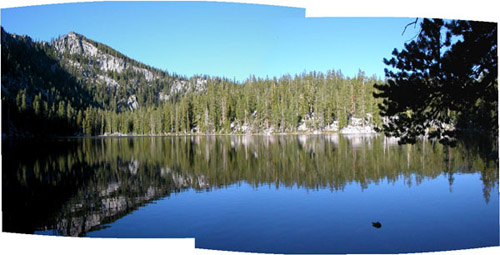
Watching patiently through her new binoculars, Barbara spotted
a mountain chickadee, a yellow rumped warbler, and a woodpecker.
The woodpecker was unusual, with white head, a red patch on the
back of the head, and a large white patch on the outer part of
the wing. We later found out it was a white-headed woodpecker,
found in mountain pine forests of the Pacific states.
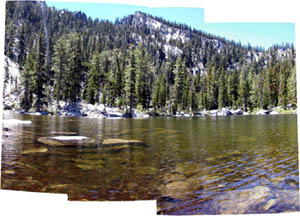 After
breakfast we hiked around the lake clockwise from our campsite
on the north end. The going was not easy. The trail hugged the
shore on the east slope, except for a few rough scrambles over
steep rock falls. Just before reaching the inlet stream from the
upper lake, we found one not-so-great campsite. The narrow isthmus
between Upper and Lower Eaton Lakes was bouldery and brushy with
no apparent trail. We fought our way through to the upper lake,
which was shallow and small, but ruggedly beautiful. The shore
was a heap of huge jagged boulders, broken away from the peak
above. A few sat in the water as islands. No level tent site was
apparent in the thick undergrowth. After
breakfast we hiked around the lake clockwise from our campsite
on the north end. The going was not easy. The trail hugged the
shore on the east slope, except for a few rough scrambles over
steep rock falls. Just before reaching the inlet stream from the
upper lake, we found one not-so-great campsite. The narrow isthmus
between Upper and Lower Eaton Lakes was bouldery and brushy with
no apparent trail. We fought our way through to the upper lake,
which was shallow and small, but ruggedly beautiful. The shore
was a heap of huge jagged boulders, broken away from the peak
above. A few sat in the water as islands. No level tent site was
apparent in the thick undergrowth.
Continuing along the fisherman's trail we came to a very good
campsite on the west shore. In the tall forest stood a huge fire
ring and several level tent sites. It had the look of a horse
camp, and, indeed, we scuffed through traces of ancient horse
manure. This we found odd. To get a horse in there would require
either the difficult circumnavigation of three-quarters of the
lake, as we had just done, or crossing a rugged boulder field
and outlet stream from our camp. Or was there another explanation?
After lunch we followed a vague track winding up the hillside
above the horse camp. The going was rough and the path less than
obvious, perhaps only a game trail. From the top of the moraine
above the lake the vague tread seemed to lead on to the west,
to dip into a shallow valley and then, perhaps, to rise toward
the next ridge. Beyond that ridge lay the Duck Creek drainage.
With the thrill of Vasco da Gama as he first rounded the Cape
of Good Hope, we wondered if perhaps we had found the elusive
direct route between Big Duck and Eaton Lakes. Horses might be
able to cross-country from Big Duck Lake to this horse camp without
crossing the boulder field at the Eaton's outlet.
We, however, did have to cross the boulder field to complete
our hike around the lake. Here the boulders were not the gentle
pillow shapes of the Buddha garden, but were huge and sharp-edged
and jumbled as if freshly severed by a colossal axe from Eaton
Peak far to the south. Unlike the boulders ground round and smooth
by years of churning within the glacier, these seemed to have
been transported intact by some other geological process. Maybe
they once formed a subterranean outcropping of the granitic bedrock
and were fractured in place by freezing and thawing, then washed
clean by periodic flooding from the lakes. More likely they had
recently splintered off Eaton Peak and slid down the face of a
glacier or snowfield blanketing the lakes. In any case, the going
was extremely difficult across steep slab faces with keenly honed
edges and great gaps and hollows into which a foot could slip
and a leg be broken. There appeared to be no alternative route
short of going back. Finally at the end of the boulder field,
we crossed the outlet stream through thick pine mat manzanita,
blindly probing for solid footing amid the logs and holes and
rare patches of solid ground.
We returned to our camp to find a hole chewed in the water filter
tubing, just like at Square Lake the year before. Damn the
fuzzy little ground squirrels! Fortunately the hole was near
an end, and as our field repair we simply sliced off the bad part
and reattached the hose. After a bracing swim in the deep water
on the east side of the lake, we strolled up to the rock garden,
then climbed the ridge above it to get a clearer view down into
Scott Valley.
Thursday we were up early to watch the morning shadows shorten
over the lake, saddened to be leaving such a lovely place. We
broke camp and were on the trail by nine. The descent was steep.
Hiking down slope is always more precarious than climbing up,
testing different muscles. Overbalancing or slipping on loose
scree can have more serious consequences going down. The same
fallen trees had to be climbed, ducked, or tediously skirted.
At the junction of a spur logging road on the long exposed moraine
we finally spotted the tiny "trail" sign we had missed
on the way up and on the way out last time. The hot sun bore down.
The final descent seemed endless. It took three hours to drop
the 2000 feet to the van.
Besides our own, two Forest Service vehicles sat in the parking
lot. Maybe the rangers were clearing deadfalls off the trail to
Little Duck Lake.
As we sat in our folding chairs in the shade of the kiosk, wiping
off the sweat and sorting through our belongings, a car raced
in and two young men rushed over to the map. They wanted to fish,
they told us, and were annoyed that they could no longer drive
in on the old road to get closer to the lake. After a brief consultation,
they hoisted their fishing poles and without water or day packs
began the trek in to Big Duck Lake for the day--starting at noon!
They had no clue how long and hard a hike it was going to be.
Return to Backpacking
in Jefferson
|